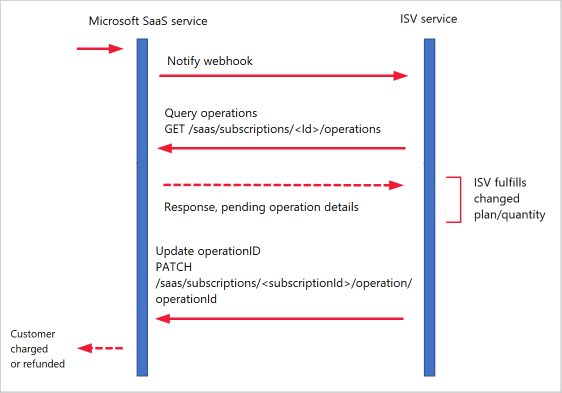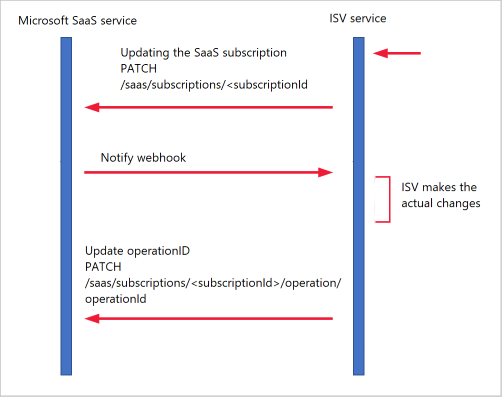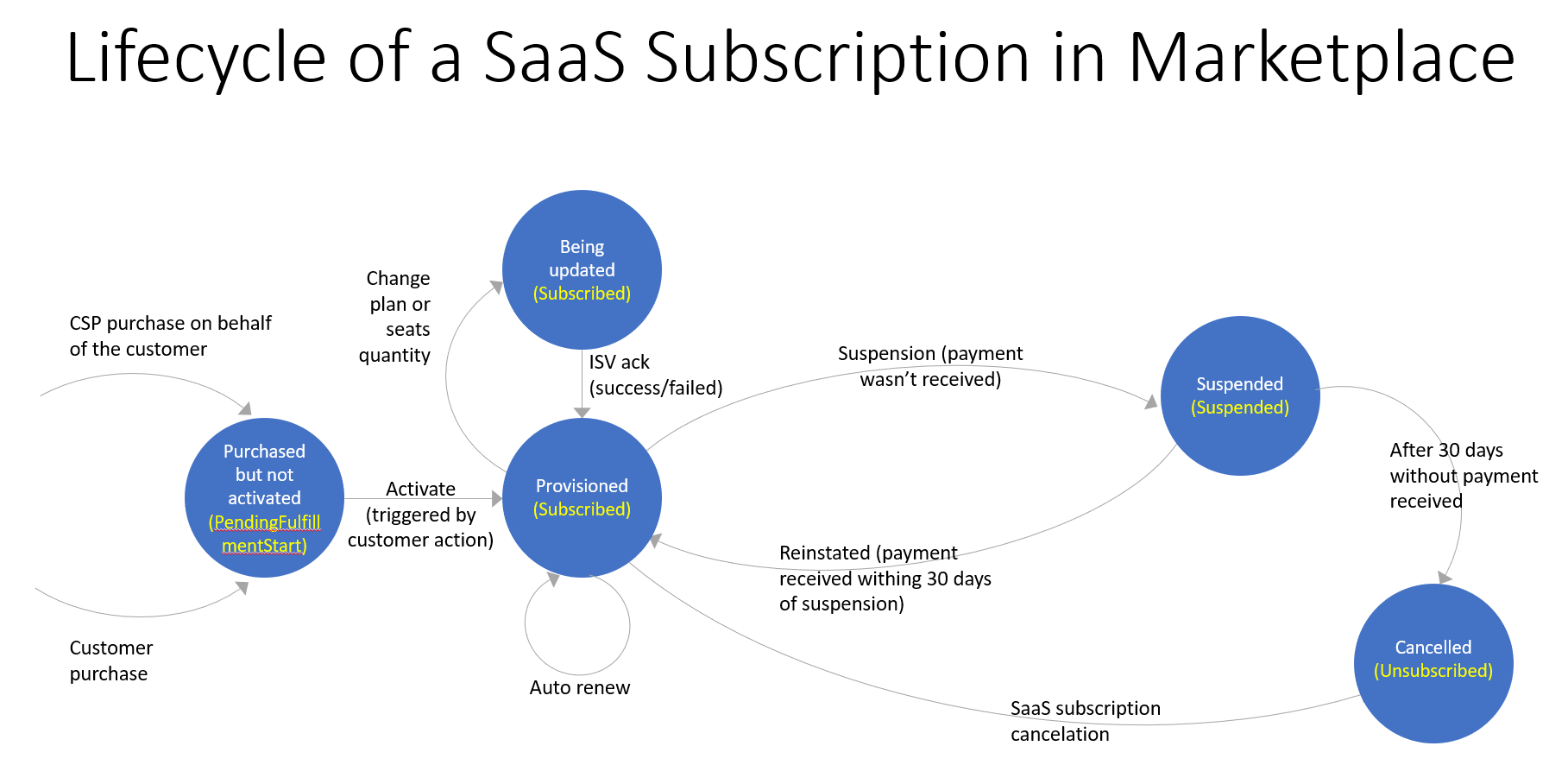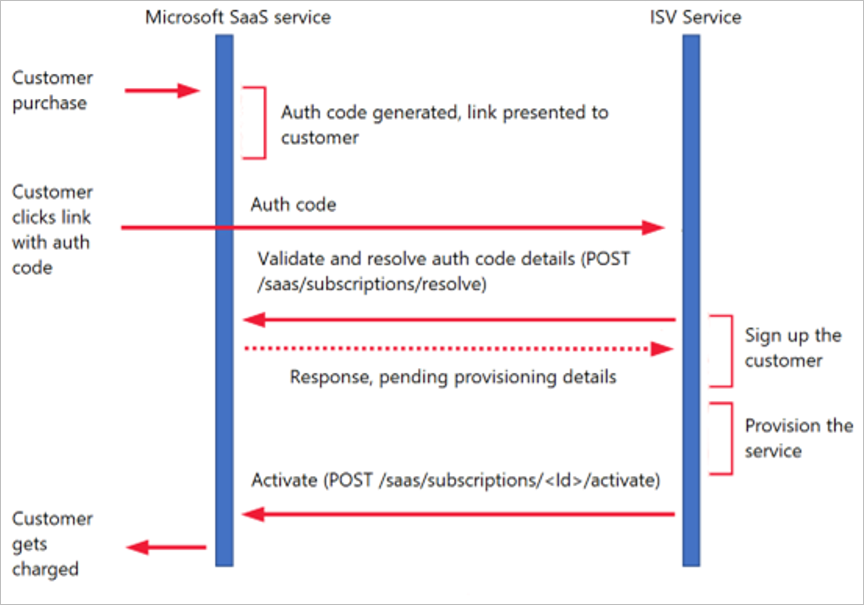Managing the SaaS subscription life cycle
The commercial marketplace manages the entire life cycle of a SaaS subscription after its purchase by the end user. It uses the landing page, Fulfillment APIs, Operations APIs, and the webhook as a mechanism to drive the actual SaaS subscription activation, usage, updates, and cancellation. The end user's bill is based on the state of the SaaS subscription that Microsoft maintains.
States of a SaaS subscription
The following diagram shows the states of a SaaS subscription and the applicable actions.
Purchased but not yet activated (PendingFulfillmentStart)
After an end user or cloud solution provider (CSP) purchases a SaaS offer in the commercial marketplace, the publisher is notified of the purchase. The publisher can then create and configure a new SaaS account on the publisher side for the end user.
For account creation to happen:
- The customer selects the Configure account now button that's available for a SaaS offer after its successful purchase in Microsoft AppSource or the Azure portal. Alternatively, the customer can use the Configure now button in the email that they'll receive shortly after the purchase.
- Microsoft then notifies the partner about the purchase by opening the landing page URL with the token parameter (the purchase identification token from the commercial marketplace) in the new browser tab.
An example of such call is https://contoso.com/signup?token=<blob>, but the landing page URL for this SaaS offer in Partner Center is configured as https://contoso.com/signup. This token provides the publisher with an ID that uniquely identifies the SaaS purchase and the customer.
Tip
Don't include the pound sign character (#) in the landing page URL. Otherwise, customers can't access your landing page. The publisher has 30 days to resolve the asset when the status is PendingFulfillmentStart. Otherwise, the asset is voided. Because the billing cycle wasn't initiated and the respective purchase isn't billed, the status then changes to Unsubscribed. The customer isn't billed for the purchase.
Important
The landing page URL must be up and running all day, every day, and ready to receive new calls from Microsoft always. If the landing page becomes unavailable, customers can't sign up for the SaaS service and start using it.
Next, the publisher must pass the token back to Microsoft by calling the SaaS Resolve API, and entering the token as the value of the x-ms-marketplace-token header parameter. As the result of the Resolve API call, the token is exchanged for details of the SaaS purchase such as the unique ID of the purchase, purchased offer ID, and purchased plan ID.
On the landing page, the customer should be signed in to the new or existing SaaS account via Microsoft Entra single sign-on (SSO).
Note
The publisher isn't notified of the SaaS purchase until the customer initiates the configuration process from the Microsoft side.
The publisher should implement SSO to provide the user experience required by Microsoft for this flow. Make sure to use the multitenant Microsoft Entra application and allow both work and school accounts or personal Microsoft accounts when configuring SSO. This requirement applies only to the landing page, for users who are redirected to the SaaS service when already signed in with Microsoft credentials. SSO isn't required for all sign-ins to the SaaS service.
Note
If SSO requires that an administrator must grant permission to an app, the description of the offer in Partner Center must disclose that admin-level access is required. This disclosure is to comply with commercial marketplace certification policies.
After sign in, the customer should complete the SaaS configuration on the publisher side. Then, the publisher must call the Activate Subscription API to send a signal to Azure Marketplace that the provisioning of the SaaS account is complete. This action starts the customer's billing cycle. If the Activate Subscription API call isn't successful, the customer isn't billed for the purchase.
Both the purchaser and the billing account owner receive an email requesting them to configure the account.
Note
The Publisher has 30 days to resolve the asset when the status is PendingFulfillmentStart. Otherwise, the asset is voided since the billing cycle wasn't initiated and the respective purchase isn't billed. The status changes to Unsubscribed. The customer isn't billed for the purchase.
Active (Subscribed)
Active (Subscribed) is the steady state of a provisioned SaaS subscription. After the Microsoft side processes, the Activate Subscription API call, the SaaS subscription is marked as Subscribed. The customer can now use the SaaS service on the publisher's side and is billed.
When a SaaS subscription is already active, the customer can select Manage SaaS experience from the Azure portal or Microsoft 365 Admin Center. This action also causes Microsoft to call the landing page URL with the token parameter, as happens in the Activate flow. The publisher should distinguish between new purchases and the management of existing SaaS accounts, and handle this landing page URL call accordingly.
An activation notification email is sent to both the purchaser and the billing account owner.
Being updated (Subscribed)
This action means that an update to an existing active SaaS subscription is processing by both Microsoft and the publisher. Updates initiate by:
- The customer from the commercial marketplace.
- The CSP from the commercial marketplace.
- The customer from the publisher's SaaS site (but not for CSP-made purchases).
Two types of updates are available for a SaaS subscription:
- Update plan when the customer chooses another plan for the subscription.
- Update quantity when the customer changes the number of purchased licenses for the subscription.
Only an active subscription can be updated. While the subscription is being updated, its state remains Active on the Microsoft side.
Update initiated from the commercial marketplace
In this flow, the customer changes the subscription plan or quantity of licenses from the Azure portal or Microsoft 365 Admin Center.
- After an update is entered, Microsoft will call the publisher's webhook URL, configured in the Connection webhook field on the Technical configuration page in Partner Center, with an appropriate value for action and other relevant parameters.
- The publisher side should make the required changes to the SaaS service, and notify Microsoft when finished by calling the Update Status of Operation API.
- If the patch is sent with fail status, the update process doesn't finish on the Microsoft side. The SaaS subscription keeps the existing plan and quantity of licenses.
Note
The publisher should invoke PATCH to update the Status of Operation API with a Failure/Success response within a 10-second time window after receiving the webhook notification. If PATCH of operation status isn't received within the 10 seconds, the change plan is automatically patched as Success.
The sequence of API calls for an update scenario that initiates from the commercial marketplace is shown in the following diagram.

Update initiated from the publisher
In this flow, the customer changes the subscription plan or quantity of licenses purchased from the SaaS service itself.
- Before the requested change is made on the publisher side, the publisher code must call the Change Plan API or the Change Quantity API or both.
- Microsoft applies the change to the subscription, and then notify the publisher via Connection webhook to apply the same change.
- Only then should the publisher make the required change to the SaaS subscription, and notify Microsoft when the change is done by calling Update Status of Operation API.
The sequence of API calls for an update scenario that initiates from the publisher side is shown in the following diagram.

A notification email indicating a plan change is sent to both the purchaser and the billing account owner.
A notification email indicating a change in quantity is sent to both the purchaser and the billing account owner.
Suspended (Suspended)
This state indicates that a customer's payment for the SaaS service wasn't received. Microsoft notifies the publisher of this change in the SaaS subscription status. The notification is done via a call to webhook with the action parameter set to Suspended.
The publisher might or might not make changes to the SaaS service on the publisher side. We recommend that the publisher makes this information available to the suspended customer and limits or blocks the customer's access to the SaaS service. There's a probability that the payment isn't ever received.
Note
Microsoft gives the customer a 30-day grace period before automatically canceling the subscription. After the 30-day grace period is over, the webhook receives an Unsubscribe action.
When a subscription is in the Suspended state:
- The partner or ISV must keep the SaaS account in a recoverable state, so that full functionality can be restored without any loss of data or settings.
- The partner or ISV should expect a request to reinstate the subscription, if the payment is received during the grace period, or a request to de-provision the subscription at the end of the grace period. The webhook mechanism sends both requests.
The subscription state is changed to Suspended on the Microsoft side before the publisher takes any action. Only Active subscriptions can be suspended.
A notification email indicating the change in status to Suspended is sent to both the purchaser and the billing account owner.
Following a 30-day period of suspension, an email regarding the post-suspension cancellation is sent to both the purchaser and the billing account owner.
Reinstated (Suspended)
This action indicates that the customer's payment instrument is valid again. A payment was made for the SaaS subscription and the subscription is reinstated. In this case:
- Microsoft calls webhook with an action parameter set to the Reinstated value.
- The publisher makes sure that the subscription is fully operational again on the publisher side.
- The Reinstate process is successful and the customer is billed again for the SaaS subscription.
Only a suspended subscription can be reinstated. The suspended SaaS subscription remains in a Suspended state while it's being reinstated. After this operation finishes, the subscription's status becomes Active.
An email is sent to both the purchaser and the billing owner following the transition from suspended state to reinstated state.
Renewed (Subscribed)
Microsoft automatically renews the SaaS subscription at the end of the subscription term of a month or a year. The default for the autorenewal setting is true for all SaaS subscriptions. Active SaaS subscriptions continue to be renewed with a regular cadence. Microsoft provides inform-only webhook notifications for renew events. A customer can turn off automatic renewal for a SaaS subscription via the Microsoft 365 Admin Portal. In this case, the SaaS subscription is automatically canceled at the end of the current billing term. Customers can also cancel the SaaS subscription at any time.
Only active subscriptions are automatically renewed. Subscriptions stay active during the renewal process, and if automatic renewal succeeds. After renewal, the start and end dates of the subscription term are updated to the new term's dates.
If an autorenewal fails because of an issue with payment, the subscription becomes Suspended and the publisher is notified.
Reminder emails for renewal are sent to both the purchaser and the owner of the billing account, 30 days before the annual/multiyear renewal date.
Canceled (Unsubscribed)
Subscriptions reach this state after an explicit customer or CSP action takes place to cancel the subscription. They cancel a subscription from the publisher site, the Azure portal, or the Microsoft 365 Admin Center. A subscription is also canceled implicitly, as the result of nonpayment of dues and after being in the Suspended state for 30 days.
After the publisher receives a cancellation webhook call, they should retain customer data for recovery on request for at least seven days. Only then can customer data be deleted.
A SaaS subscription can be canceled at any point in its life cycle. After a subscription is canceled, it can't be reactivated.
Cancellation email is sent to both the purchaser and the owner of the billing account.
Related content
Video tutorials

